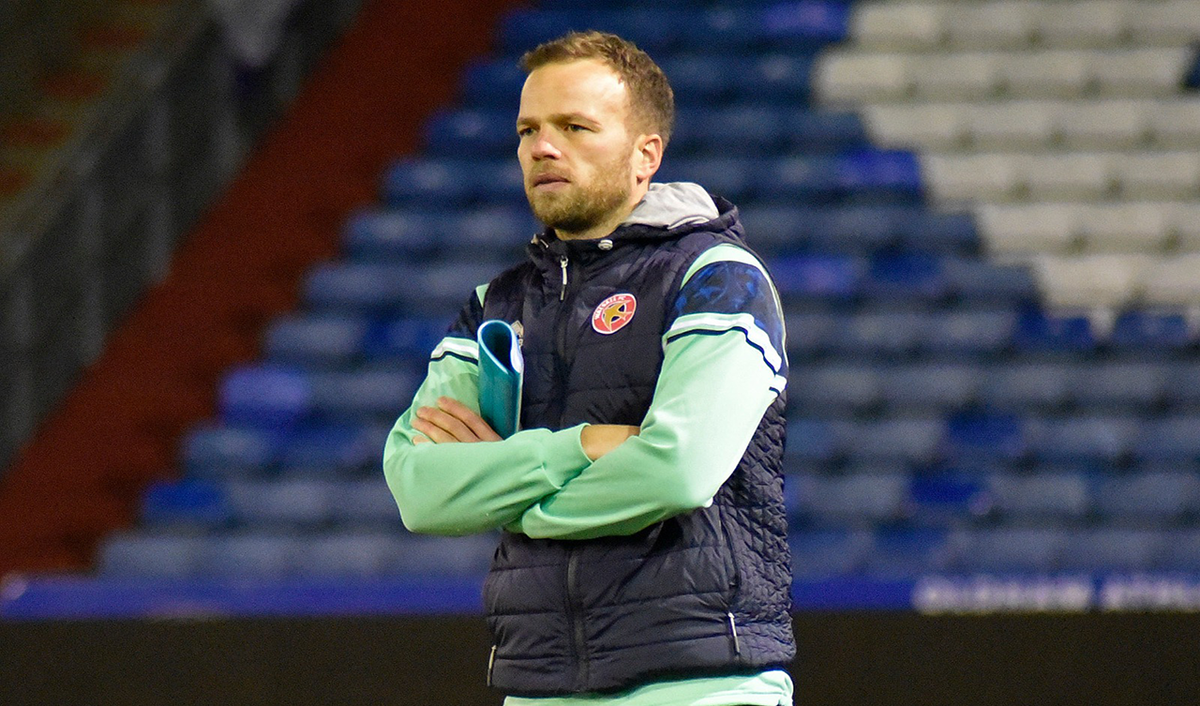Attacking and counter-pressing
This training session has all four aspects of the game rolled into one activity. We’re not only coaching attacking play, but also defence, the transition from attack to defence and the transition of defence to attack.

| Area | Two thirds of pitch |
| Equipment | Balls, bibs, cones, 2 full size goals |
| No. of Players | 22 players + 2 goalkeepers |
| Session Time |
Wave game: 24mins, Progression: 16mins |
This training session has all four aspects of the game rolled into one activity. We’re not only coaching attacking play, but also defence, the transition from attack to defence and the transition of defence to attack.
The main body of the session is made up of a competitive wave game, which allows for lots of opportunities to attack and score goals and this makes for a highly enjoyable and intensive session for the players.
While it creates plenty of attacking chances, it is also a good activity to rehearse counter-pressing because the attacking team have to counter-press immediately on losing the ball in order to prevent a counter-attack.
If it’s a full week of training with no midweek match, it’s the kind of session we would run in the early part of the week because of its high intensity nature and due to the large area that the players have to cover.
COUNTER-PRESS WAVE GAME
We set up a playing area between the 18-yard boxes, using the full width of the pitch and with wide zones marked out. We position a goal and a goalkeeper at either end. We’re using 22 players split into three teams of six and a neutral team of four floaters. The four yellow neutrals are positioned in the wide zones, as shown. A team of six starts at each end as defenders and the remaining team of six starts on the halfway line as attackers.
The attacking team begins with the ball and they must attack one end and create a scoring opportunity, if needed using the support of the two neutral wide players at the end of the pitch they are attacking. This creates an 8v6 overload, as shown [1a], and they have 90 seconds to score a goal. If the ball goes out of play during the initial attack, the game restarts with a throw from the attacking team or the coach will pass another ball in from the halfway line to the attacking side.
1a

2. The team of six attackers (the blues) starts on the halfway line and they have 90 seconds to score a goal
3. The yellow neutrals in the wide zones play for the attacking team at the end that is under attack
If the attacking team is successful in scoring in the first 90 seconds, they receive a second ball from the coach on the halfway line and then they must attack the defending team at the other end with the help of the two neutrals in the wide zone at that end, as shown [1b].
1b

2. The blues then attack the green defending team at the other end with the help of the two yellow neutrals in the wide zones at that end
3. The green defending team must wait by their goalkeeper until the attacking team first crosses the halfway line. Then they are free to defend
4. The red defending team that were just attacked go to wait by their goalkeeper for the next attack that comes their way
The defending team must try and repel the attacking team for 90 seconds and if they win possession they should launch a counter-attack by getting the ball across the halfway line to become the new attacking team against the defending team in the other half.
The team that lost the ball must immediately counter-press to prevent the counter-attacking team getting across the halfway line. The defending team at the other end must wait by their keeper until the counter-attacking team first crosses the halfway line, as shown [1c].
1c

2. The blue team that lost the ball must immediately counter-press to prevent the red defending team counter-attacking across the halfway line
3. Once over the halfway line, the reds can attack with the help of the two neutrals in the wide zones at that end
4. The defending team at the other end must wait by their keeper until the red counter-attacking team first crosses the halfway line, then they can move forward to defend
The team with the most goals wins the game.
Before moving on to the progression, we would extend play to the full width of the pitch, with both the attacking and defending teams being allowed to move into the wide areas. However, the yellow neutrals are still restricted to staying in the wide zones but they can now assist with the counter-press when the attacking team loses possession if play comes into their zones. This helps to stop the defensive team counter-attacking across the halfway line.
PROGRESSION
To progress the activity, we remove the wide channels and play the same game, using the full width of the pitch. We now have just one neutral, who plays in the main area for the team in possession, and the two defending teams and the one attacking team are now made up of seven players each, giving the attacking team an 8v7 overload.
We play just as before, with the attacking team going up against the defending team with 90 seconds to score, as shown [2], before being served a second ball by the coach and attacking the defenders at the other end.
2

2. The defending and attacking teams are now made up of seven players each
3. There is now only one neutral who plays in the main area for the team in possession, giving the attacking team an 8v7 overload
What are the key things to look for?
From the attacking aspect we are looking for players to move the ball decisively and intelligently and also to demonstrate an understanding of how best to use the overload. Most importantly we need to keep a defensive structure to our attacks to prevent being counter-attacked and to help with the counter-press.
Defensively, we’re working hard to prevent being attacked through the middle of the pitch and trying to funnel the ball into the wide areas, then setting up to defend the cross and any second phases.
We also want to try and counter-attack when the correct moments arrive, intelligently understanding the risk and reward factors.
What are the typical mistakes players might make and how do I avoid them?
Typical mistakes from an attacking point of view would be players taking too many touches and slowing the game down, and also dribbling when the team is not structured to help defend the counter-attack from an unsuccessful dribble.
Typical mistakes from a defensive point of view would be staying too deep and not quickly getting up to the player and the ball to defend properly.
How would I put this in a game situation?
This session would just roll into a 9v9 game or a 11v11 game.
Editor's Picks
Attacking transitions
Deep runs in the final third
Using the goalkeeper in build-up play
Intensive boxes drill with goals
Penetrating the final third
Creating and finishing
My philosophy
Pressing initiation
Compact team movement
Coaches' Testimonials

Alan Pardew

Arsène Wenger

Brendan Rodgers

Carlos Carvalhal

José Mourinho

Jürgen Klopp

Pep Guardiola

Roy Hodgson

Sir Alex Ferguson

Steven Gerrard
Coaches' Testimonials

Gerald Kearney, Downtown Las Vegas Soccer Club

Paul Butler, Florida, USA

Rick Shields, Springboro, USA

Tony Green, Pierrefonds Titans, Quebec, Canada
Join the world's leading coaches and managers and discover for yourself one of the best kept secrets in coaching. No other training tool on the planet is written or read by the calibre of names you’ll find in Elite Soccer.
In a recent survey 92% of subscribers said Elite Soccer makes them more confident, 89% said it makes them a more effective coach and 91% said it makes them more inspired.
Get Monthly Inspiration
All the latest techniques and approaches
Since 2010 Elite Soccer has given subscribers exclusive insight into the training ground practices of the world’s best coaches. Published in partnership with the League Managers Association we have unparalleled access to the leading lights in the English leagues, as well as a host of international managers.
Elite Soccer exclusively features sessions written by the coaches themselves. There are no observed sessions and no sessions “in the style of”, just first-hand advice delivered direct to you from the coach.









